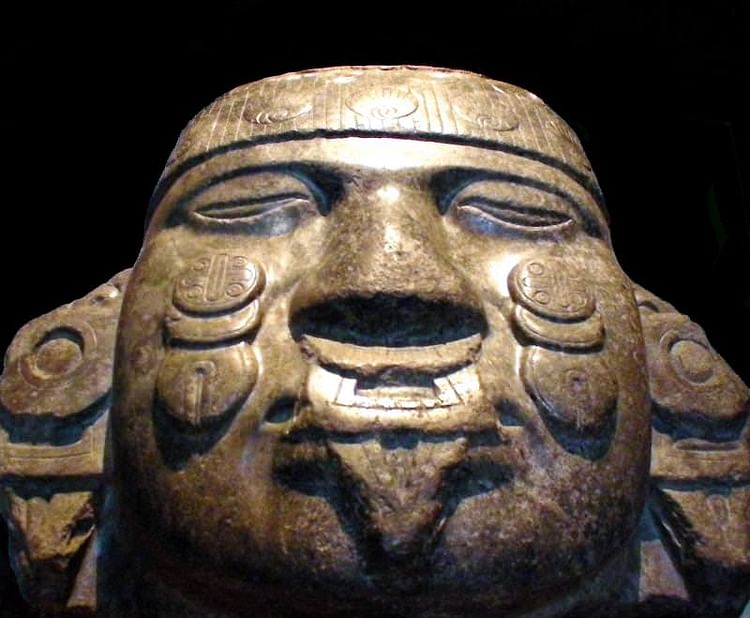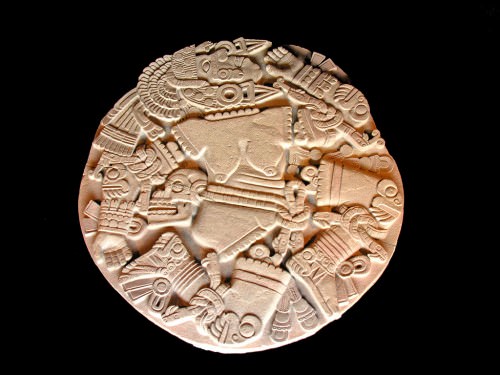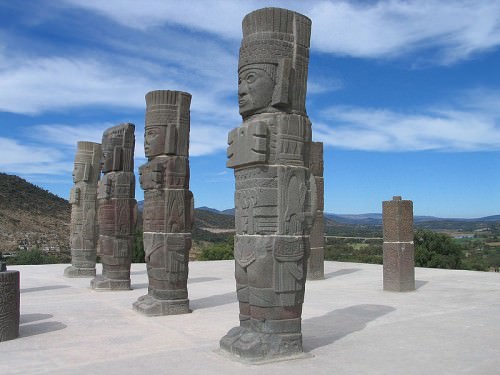Coyolxauhqui › Mixcoatl » Ancient origins
Articles and Definitions › Contents
- Coyolxauhqui › Who Was
- Mixcoatl › Who Was
Ancient civilizations › Historical and archaeological sites
Coyolxauhqui › Who Was
Definition and Origins

Coyolxauhqui ( pron. Koy-ol-shauw-kee) was the Aztec goddess of the Moon or Milky Way who was famously butchered by her brother Huitzilopochtli, the god of war, in Aztec mythology. This story was commemorated in a celebrated large relief stone found at the foot of the pyramid of sacrifices, the Templo Mayor at the Aztec capital Tenochtitlan.
COYOLXAUHQUI VS. HUITZILOPOCHTLI
Coyolxauhqui, whose name signifies 'Painted with Bells', was considered either the sister or mother of Huitzilopochtli, the Aztec god of war and patron of Tenochtitlan. In the first version of this mythical duel, Coyolxauhqui upset her son Huitzilopochtli when she insisted on staying at the legendary sacred mountain Coatepec ('Snake Mountain', also spelt Coatepetl) and not following Huitzilopochtli's plan to re-settle at a new site – the eventual Tenochtitlan. The god of war got his own way by decapitating and eating the heart of Coyolxauhqui, after which he led the Aztecs to their new home.
In the second version of this family strife, rebellious Coyolxauhqui led her 400 brothers, known as the Centzon Huitznaua (the 'Four Hundred Huiztnaua' who represented the stars of the southern sky), in a bid to kill her mother, the goddess Coatlicue.The pretext for this attack had been the news that Coatlicue had become pregnant in somewhat bizarre and dishonourable circumstances. Performing her duties, one day, as a cleaner at the shrine on the top of the sacred mountain Coatepec, a ball of feathers suddenly descended from the heavens and when Coatlicue tucked this into her belt it miraculously impregnated her. The resulting child was none other than the powerful warrior Huitzilopochtli.
HUITZILOPOCHTLI CHOPPED UP COYOLXAUHQUI INTO SEVERAL LARGE CHUNKS AND LOBBED THE PIECES DOWN THE SACRED SNAKE MOUNTAIN.
Coyolxauhqui's plot came unstuck, though, when one of the Huiztnaua lost heart and decided to warn the still unborn Huitzilopochtli. Rising to his mother's defence the god sprang from the womb fully-grown and fully-armed as an invincible warrior. In another version, the god springs from his mother's severed neck after Coyolxauhqui had decapitated her. Either way, with his formidable weapon, the xiuhcoatl ('Fire Serpent') which was actually a ray of the sun, the warrior-god swiftly butchered his unruly siblings and, chopping up Coyolxauhqui into several large chunks, he lobbed the pieces down the mountainside. The head of the goddess was tossed into the sky and so became the moon.
This gruesome sibling myth may symbolise the daily victory of the Sun (one of Huitzilpochtli's associations) over the Moon and stars. That is even if the association with the moon has no particular archaeological evidence to support it and some scholars have argued that Coyolxauhqui was, instead, associated with the Milky Way.
THE GREAT COYOLXAUHQUI STONE
The myth of Coyolxauhqui's demise at the hands of Huitzilopochtli was commemorated in a large stone disk, known as the Great Coyolxauhqui Stone, which was excavated at the base of the Templo Mayor, Tenochtitlan. It depicts in high relief the dismembered and decapitated corpse of Coyolxauhqui and dates to c. 1473 CE during the reign of Axayacatl. The goddess wears only a warrior's belt with skull, a headdress with eagle down feathers, and a bell on her cheek. The Templo Mayor pyramid was actually a twin shrine to the rain god Tlaloc and the war god Huitzilopochtli. A double staircase climbed the temple, and the disk was placed, significantly, at the base of the steps leading to Huitzilpochtli's shrine. It was atop this temple that humans were sacrificed and their bodies dismembered and tossed down the steps to land at the base, just as in the myth on Snake Mountain.

Coyolxauhqui
Besides reminding of the importance of Huitzilopochtli, the stone was also a stark warning to the enemies of the Aztecs who saw themselves as the victorious warrior Huitzilopochtli. Defeated warriors led up the steps of the Temple Mayor for the ultimate sacrifice would have been reminded that they were soon to be the equivalent of the defeated Coyolxauhqui.
The 3.4 m (10.5 ft) diameter stone was re-discovered in 1978 CE when workers were excavating the basement of a bookstore in downtown Mexico City. In condensing a three-dimensional scene onto a two-dimensional plain, it is one of the great masterpieces of Aztec art and now resides in the Museo del Templo Mayor in the city in which it was discovered.
OTHER REPRESENTATIONS IN ART
Other notable representations of Coyolxauhqui are a fragmentary greenstone (diorite) slab which is older and (along with a stucco sculpture of the goddess) lay beneath the stone disk described previously. This earlier stone shows Huitzilopochtli's xiuhcoatl weapon piercing the goddess' chest and probably dates to the reign of Motecuhzoma I (1440-1469 CE).
Another famous representation of Coyolxauhqui is a large greenstone severed head found at Tenochtitlan which was probably carved during the reign of Ahuitzotl (1486-1502 CE). The goddess once again has the golden coyolli bells on each cheek.This head now resides in the Museum of Anthropology in Mexico City.
Mixcoatl › Who Was
Definition and Origins

Mixcoatl, 'Cloud Serpent,' was a Mesoamerican god identified with hunting, the Milky Way and the stars and heavens in general. The god may originally have derived from a deified hunter and warrior-leader of the Toltec -Chichimec peoples of central Mexico. In mythology, he is the father of the southern constellations and the great Mesoamerican god Quetzalcoatl.
NAME & ASSOCIATIONS
The name Mixcoatl may be literally translated as 'Cloud Serpent' which is how the ancient Mesoamericans imagined the Milky Way in the night sky. Mixcoatl was the son of the primordial creator gods Tonacatecuhtli and Tonacacihuatl in some traditions;in others, he was the son of the earth goddess Itzpapalotl ('Obsidian Butterfly') while his wife was Coatlicue ('Serpent Skirt'), another earth-fertility goddess. Mixcoatl was considered the father of the Centzon Huitznahua, the 400 sons representing the southern stars. Also, by changing himself into a deer and forcing his attentions on either the great huntress Chimalman or the earth goddess Cihuacoatl, he was parent to Quetzalcoatl, the great feathered serpent god of Mesoamerica.
MIXCOATL MAY BE LITERALLY TRANSLATED AS 'CLOUD SERPENT' WHICH IS HOW THE ANCIENT MESOAMERICANS IMAGINED THE MILKY WAY.
Mixcoatl was the patron or main god of the Chichimecs (and many other peoples who claimed descent from them) and the Otomi of central Mexico. As Camaxtl he was especially worshipped at Huejotzingo and Tlaxcala. The later Aztecs largely replaced Mixcoatl with their own powerful sun and war god Huitzilopochtli, although he was associated with Red Tezcatlipoca, an aspect of the all-seeing and omnipresent supreme god of the Aztec pantheon Tezcatlipoca. In one tradition Tezcatlipoca transformed himself into Mixcoatl and then invented the fire-drill for the benefit of humanity. Finally, Mixcoatl was associated with lightning, thunder, and the direction North.
FESTIVALS & WORSHIP
Mixcoatl the god was associated with the 14th Aztec month, Quecholli (a type of bird), when feasts and hunts were held in his honour on Mt. Zacatepetl. The hunters dressed themselves as the god, made arrows, and set ritual fires to commemorate this gift. It was during this festival that women took their young children to dance with Mixcoatl's priestesses, who were given cakes. Bloody human sacrifices were made to the god, too, described here by the historian ME Miller:
A man and a woman were sacrificed to Mixcoatl in his temple. The female victim was slain like a wild animal;her head was struck against a rock until she was half-conscious; then her throat was slit and the head decapitated. The male victim displayed the head to the assembled crowds before he himself was sacrificed by heart extrusion. (116)
Mixcoatl, along with various other hunting gods and Tezcatlipoca, was also honoured during the 5th month of Toxcatl ('Drought') with a festival which included another round of actual animal hunts and a staged hunt of prisoners of war dressed as deer. Feasts and the sacrifice of honoured god-impersonators rounded off the festivities.

Toltec Warrior Columns
THE TOLTEC MIXCOATL
Something like Hercules in Greek mythology, Mixcoatl was perhaps originally an ordinary mortal who gained fame, and as a great hunter, warrior, and leader, consequently earned his deification. The Toltec Civilization flourished between the 10th and mid-12th century CE in central Mexico, and according to tradition, their legendary chieftain Ce Tecpatl Mixcoatl ('One Flint Cloud Serpent') led them from the deserts of the north-west to Culhuacan in the Valley of Mexico. Mixcoatl, by impregnating with an arrow his wife, a local Nahua woman named Chimalman, had a son, Ce Acatl Topiltzin who was born on the day 1 Reed, either 935 or 947 CE. Topiltzin took on the honorary title Quetzalcoatl and won great renown as he consolidated and expanded the Toltec-Chichimeca empire with its impressive capital at Tollan.
REPRESENTATION IN ART
The god is represented on the gilded handle of an Aztec hardwood dart thrower ( atl-atl ) now in the British Museum, London.Here he wears a fanged mask, ear-spools in the form of deer hooves, and an eagle-feather headdress while battling a rattlesnake. Mixcoatl appears in codices wearing red and white striped body paint, a black mask on the upper part of his face, and eagle feathers. As with other star-associated gods, he may have stars on his face. He is typically carrying a bow, bunch of arrows, and a hunting net or basket and is sometimes in the act of slaying a jaguar, reminding of his role as patron of hunters.
LICENSE:
Article based on information obtained from these sources:with permission from the Website Ancient History Encyclopedia
Content is available under License Creative Commons: Attribution-NonCommercial-ShareAlike 3.0 Unported. CC-BY-NC-SA License